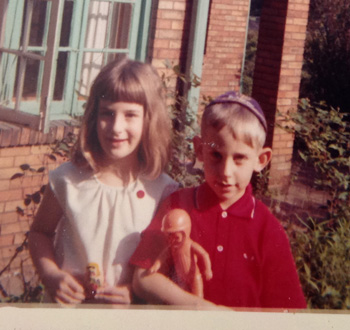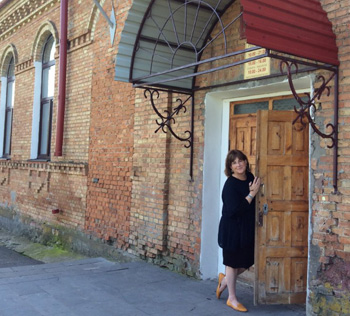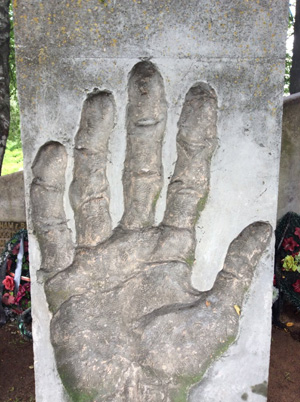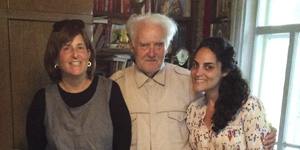By Rivy Kletenik, Jewish Sound Columnist
Here I am in June of 1964, about to turn 6, holding my first Matryoshka doll. I am standing next to my twin, who is proudly displaying his cosmonaut. That wooden “little matron,” a gift from my parents’ trip to Russia, kicked off a lifetime curiosity —the third-grade country project on Russia, the piano pounding of “Volga Boat Man.” Then the books: “Nicholas and Alexandra,” “Doctor Zhivago,” “Anna Karenina,” “War and Peace,” Chekhov, Turgenev. And of course the food: Borscht, pirog, herring, black bread. So the Pale, the Tsar’s conscriptions, the pogroms, Siberia and the communist-era plight of Soviet Jews were not so wonderful. Still, the Motherland!

This summer? The pilgrimage. My daughter Gilah, determined to fulfill her mother’s lifelong dream, set out to orchestrate and plan a mother-daughter roots trip back to the “alter heim,” to the long lost shtetlach from where her ancestors hailed.
A trip to Russia and Belarus are not your simple hop-on-the-plane destinations; there are the matters of visas, translators and drivers, along with the challenge of multi-city hotel reservations and kosher food in preparation to visit places that have heretofore been the fodder of tales from long ago: Minsk, Mir, Radun, Narvarduk, Velizh, Vitebsk, and the big cities of Moscow and St. Petersburg.
Fast forward to July. It is hot. We are traveling in a minivan with no air conditioning along a two-lane highway through Belarus. On either side we alternately pass fields of rye and corn. Soon we are weaving our way through villages with tiny wooden homes that evoke childhood memories of a Grimm’s fairytale book. We go from Minsk to Mir to Lida, and now to Radun.
Arriving here and walking on these pebbled paths is surreal. A hint, a mere vestige, an inkling is all that is left of what was once a Jewish center with shuls, markets and of course the renowned yeshiva of the Chafetz Chaim. In my mind’s eye I picture those who had once been here: The scurrying yeshiva students, the bustling women, the children at play. I close my eyes and I see my Bar Mitzvah-aged father, in this town where his father was born, where his extended family lived, and where they had come as a family to stay with the Chafetz Chaim on their way to America. I turn quickly and there he is, rushing to catch an afternoon prayer with his brothers.
The building that once housed the yeshiva still stands. It is now a cultural center. We are greeted with something less than enthusiasm when we ask to take a look around. While the woman who has been washing the floor argues with our guide, I sneak up the wooden staircase. A few sitting rooms, an accordion, bookshelves; not even a hint or smell of sefarim, siddurim or taleisim of years ago. Its Jewishness has been rigorously scrubbed clean. Though the main room downstairs still has a Jewish feel; its rectangular shape has a definite layout of a shul and beit midrash.
If you have ever visited a childhood home where others now live, you know the particular ache of longing felt as we turn to leave. It is hard to pinpoint the pain. An overwhelming blend of seeing the hollowness of the buildings once hallow, the total evaporation of the life that was once here, and the utter rootlessness of our people seemingly connected yet so seamlessly erased.

In 1931 my father and his family escaped to this town of Radun. Back then it was Poland, and free of Stalin’s severe and repressive anti-religious policies. We stand in quiet thought outside the yeshiva — they had all once stood here — that we know; rushing hurriedly with anticipation before Shabbos. Grandparents, uncles, aunts, many a relative through marriage. I am tempted to drop down and beg the pebbles and rocks to speak, to tell me everything they know.
Instead, we follow the road out of town to the Jewish cemetery. The few headstones left are worn beyond readability. The exception is the tomb of the Chafetz Chaim, which stands surrounded by pillars and is appropriately bedecked with stones, notes and candles; pilgrimages have been made here. Radunites are proud of their holy rabbi, preventing the Jewish community from ever removing his remains. The Chafetz Chaim, a champion of pure speech who would always explain his utter lack of material goods by reminding his followers that “we are only passing through.”
We make our way back to the far end of the cemetery, to the fenced-off mass grave. There is a trench and a raised area. It runs about half of the length of the Jewish cemetery. A monument stands and tells the tale of that summer of 1942; Radun’s Jews had been marched through the city then out here and shot, one by one.
Every town has its pit. The story ends here for the Jews even as life goes on in the town of Radun. No sign identifies the once-grand yeshiva and no markers tell of the life that was once here — save this memorial buried back beyond the town limits. Today, the story of Radun will have to be told by those who are only passing through.
The next day we drive four-and-a-half hours from Minsk to Velizh. Minsk is in Belarus, Velizh is in Russia. There is no official border crossing. We know we’ve crossed only because the road suddenly deteriorates. Belorussians pride themselves on their well-maintained infrastructure; dictatorship can have its benefits.
A few minutes later our guide, Irina, says, “Okay, we are in Velizh.”
Velizh. Velizh. It is our family’s Oz. What week of my childhood did not pass without a mention of Velizh? The black bread of Velizh. The herring of Velizh. The snow on the sgach of the sukkah in Velizh. The shammes of Velizh. Making matzoh in Velizh. The communists of Velizh. The school bullies of Velizh. The Dzvina River of Velizh. And finally, the escape from Velizh. We unceremoniously cross over, pull to the side and ask a passerby for directions. No response. Irina sardonically remarks, “Welcome to Russia.” As if to say, are you crazy Americans happy now? You are in Velizh. Now deal, with it.
We pull into a parking lot behind a small apartment building. Our guide runs out, shouting behind her not to leave the car. We watch the comings and goings of apartment dwellers. It is almost noon. Cars from assorted eras pull in and out. It’s steamy. I bravely open the van door and get out. I imagine word spreading through the town: Strangers have just arrived by van, pass it on.
Irina returns. Bad news. The person in charge of the town museum is undergoing surgery. But good news. They gave us the name of a man who can answer our questions. We drive to his home and with one step enter a bygone era.

The man looks at us with doubt. Through Irina we explain that my father was born in this town. My grandfather, Rabbi Eliezer Poupko, was the rabbi of this town. Might we ask you some questions about the community, the Jewish community? Awkwardness, hesitancy. Then I see a picture pinned to the wall. It looks so familiar. I have one just like it. We pull out my Ipad to show him. His family, his photo. My family, my photo. Same background. Same studio, from a Jewish photographer’s in town. We are in. He tells us we look like Jews from Velizh.
I never felt so alive. I am a Jew from Velizh.
Our new friend is a remarkable man. A hero of memories. He has determinedly set out to record the town’s most terrifying years under Nazi occupation. He may not remember my father’s era, but he tells excitedly of how the town was good with the Jews until the invasion. He tells of how as a 10-year-old boy he witnessed the shootings, and then the burning, of the Jews who had been gathered in a pigsty. He saw the most gruesome of scenes and was determined that the town never forget. He designed Velizh’s monument in memory of the murdered Jews: A grey monolith with a hand carved out, depicting the hands of those murdered struggling to get free — a scene he will never forget.
We drive past where the synagogue once stood, then visit the old Jewish cemetery off to the side of the road. No fence. No marker. Stones are scattered here and there. Grass is overgrown. Life pushes on. The one remaining Jew of Velizh died last year. Here we are, we have not forgotten you, Velizh. A Jew may leave Velizh, but Velizh does not leave the Jew.

Why do we visit? The essence of knowledge, says Plato, is self-knowledge. As we stood on the bridge over the Dzvina River, I pictured my father on its banks. Then I saw him sitting by Lake Washington. And I understood my father’s insatiable appetite for sitting by the water. That love was born here. This spot, this place, I now understand, never left my father. Every now and then we need to reconnect. Those steps backward? They give us just the right amount of soul and spirit to move ahead.